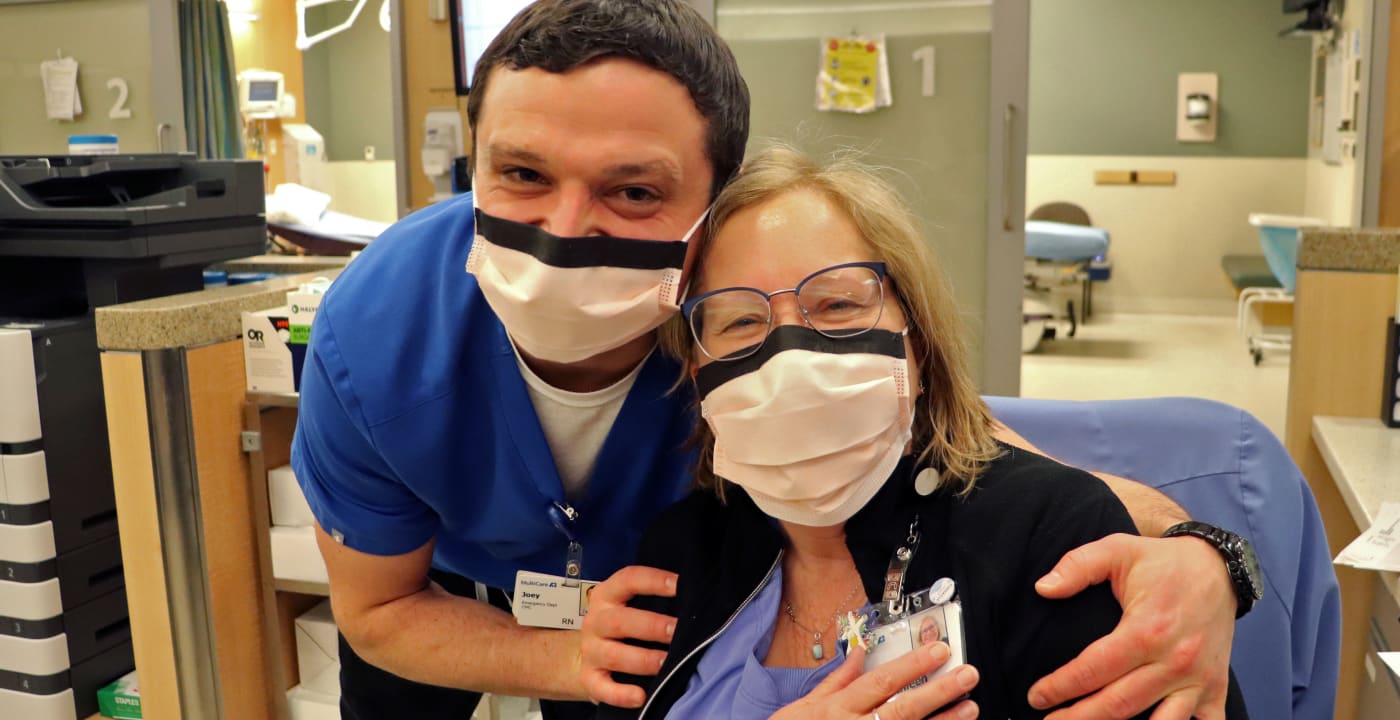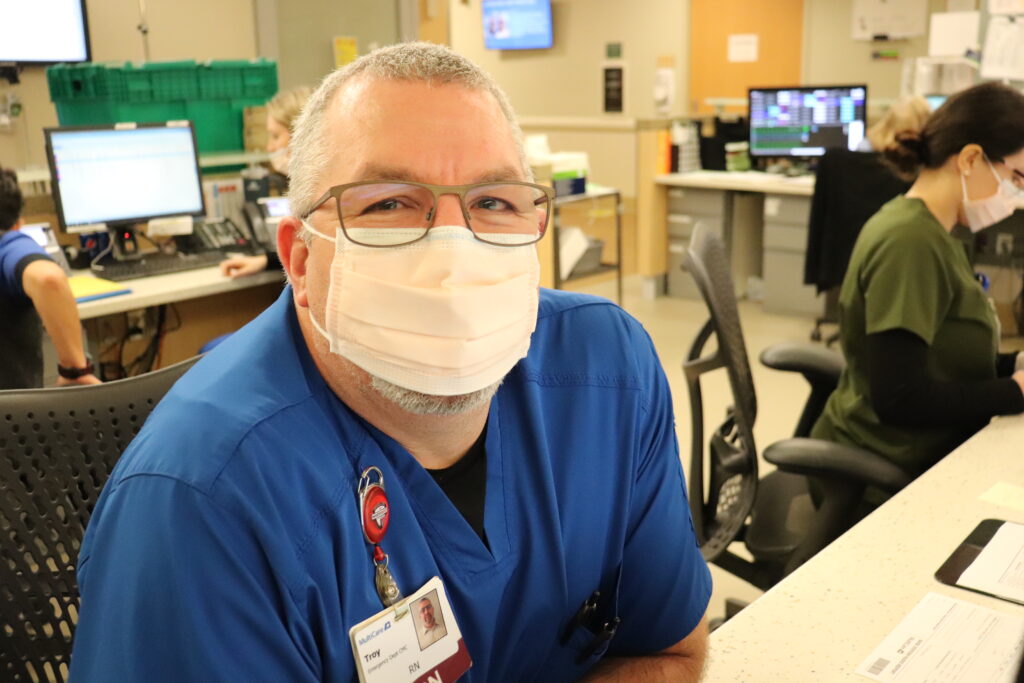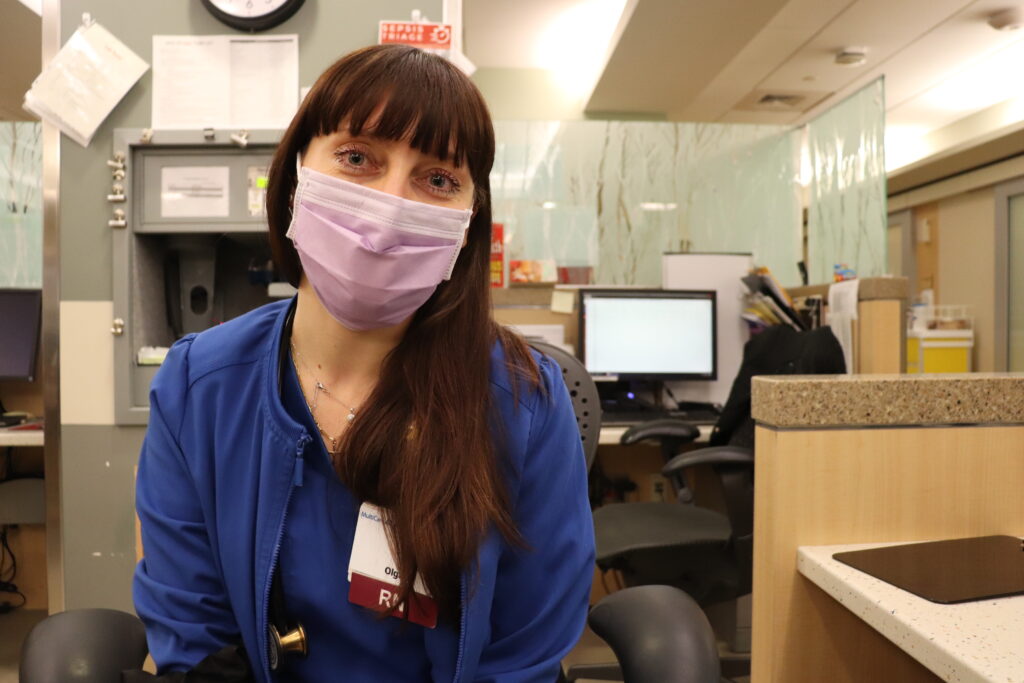A day in the Covington emergency department

Just before 7am on a Friday at MultiCare Covington Medical Center’s Emergency Department (ED), the day shift starts to trickle in and the night shift tidies up patient chart notes and gets ready to end their workday.
“Good morning! How’d it go last night?” incoming charge nurse Troy Nicholas, RN, asks Joey Blouin-Jackson, RN, the night charge nurse.
“Not bad,” Blouin-Jackson says. “It calmed down at about 3 or so.”
Nicholas asks about a patient he cared for during his previous shift. He worried about her. She was admitted and moved upstairs to the hospital, Blouin-Jackson assures him. They continue talking about other patients and news from the night before.
Everyone gathers for morning huddle, where they hear updates about the department, the hospital and MultiCare. The charge nurse relays details about patients to watch closely (those who may need care quickly due to illness, mental health or other reasons), security concerns, a procedure change and new drug shortages.
Afterward, night and day nurses pair up for handoffs. The pairs go to patient rooms, where the night nurse says goodbye and introduces the day nurse. At the bedside, they go over why the patient is in the ED and where treatment stands at that moment. This bedside handoff is good for everyone involved — it ensures incoming nurses get details about patients and patients hear the latest on their care.
By about 7:30am, the night team has gone home and the day crew has settled in. As the day progresses, the ED waiting room fills up and the wait time gets longer. Pre-pandemic, Covington Medical Center’s ED was known as a place where you could be seen quickly, with little to no waiting. This is no longer the case.
Small team, growing census
The house supervisor stops by the ED to check in. House supervisors manage staffing and patient flow for the entire hospital.
“All the rooms are full upstairs, but we’re expecting a handful of discharges today,” she says.
That’s good news. Patients who come to the ED and are admitted to the hospital have to stay in the ED until there’s an open bed at Covington Medical Center or another MultiCare hospital. Sometimes that wait only takes a few hours, but in today’s environment, it can take a day or two.
Pre-pandemic, it was common for only about 30 patients to come to the Covington Medical Center ED in a 24-hour period. Today, the number of patient visits often competes with the larger emergency department at MultiCare Auburn Medical Center, located nine miles down the highway.
This day, of the 110 patients seen in the Covington Medical Center ED, 20 were admitted. A few were taken upstairs to Covington’s private inpatient rooms while others were transferred to other MultiCare hospitals. With 58 licensed inpatient beds, Covington is the smallest of MultiCare’s 12 hospitals.
Kathleen Serafin, an emergency services representative who has been at the Covington ED since day one, has watched it steadily grow.
“When I first started, people would come here and could get right in to be seen,” she says. “That’s not the case nowadays.”
Blouin-Jackson, the night shift charge nurse, started in the Covington ED three years ago, just as COVID-19 was in full swing.
“Since I’ve been here, I’ve seen a massive increase in our census,” he says.
The population in South King County, and especially in Covington and Maple Valley, has grown tremendously. MultiCare opened a standalone ED in Covington in 2012, just a few feet from a bustling medical clinic. In 2018, MultiCare added the 58-bed inpatient hospital.
The Covington Medical Center ED has fewer staff members and fewer rooms compared to its South King County counterparts. As with all EDs around the nation, Covington teams are seeing patients who are sicker and in need of higher levels of care.
They’re also seeing sharp increases in the number of patients experiencing mental health crises, a worrisome trend, says Blouin-Jackson.
“We have limited resources,” he says. “Some nights we have psychiatric patients in three rooms and we only have one EPS room.”
Enhanced patient safety rooms (EPS) are for patients in severe mental health crisis with the potential to harm themselves or hospital staff. Auburn Medical Center, for comparison, has four EPS rooms and dedicated staff to care for patients in crisis.
Difficult days
Emergency departments are unpredictable on the best of days, but typically quieter in the early morning hours.
The ambient sounds of heart monitor beeps and call light dings are a constant, and to many employees a comforting background beat. When the steady tick of one of those monitors changes, those in hearing distance rush to check on that patient. Often it means a patient accidently plucked one of the leads from their heart monitors. But sometimes it’s a signal of distress.
Recently, the alarm on one of those monitors sounded to indicate a patient had stopped breathing. The nurse called a code for the rapid response team and a group of nurses, physicians, pharmacists and respiratory professionals came running from their work areas throughout the hospital.
The team revived the patient, but unfortunately they passed away a short time later. They had come to know this patient, who had been to the ED several times before.
Once the time of death is entered into a patient’s chart and the monitors are turned off, the sudden quiet is deafening. The code team goes back to their regular duties while a few ED team members remove tubes and monitors from the patient before the family comes in. The hope is to present their loved one in a respectful way.
It’s not easy when someone dies on your shift. By nature, people in health care are compassionate and want to help. After the code, they take a moment to center themselves and carry on — their other patients need them.
“They say ED nurses are tough, that we have no empathy,” Nicholas says. “That’s not true. You have to have a lot of caring to do this job. We see some bad stuff here.”

That same day, on top of the normal patient load of sick and injured people, the ED staff stabilized someone who had a gunshot wound and removed a nail from another patient’s leg. There were also the typical ED visits: a few broken bones, babies with high fevers and adults who just weren’t feeling well.
The Covington Medical Center ED is not a certified trauma center, but since it’s connected to a hospital, staff can care for a larger range of illnesses and injuries than those at a stand-alone ED or an urgent care. They help everyone, from babies to elders.
Working as a team
As the charge nurse, Nicholas oversees the department for that shift. He assigns nurses to patient rooms, ensures patients are discharged efficiently and steps in if any issues arise.
Serafin, the emergency services representative, works the phones, organizes patient transfers, keeps an eye on the telemonitors and makes sure everyone is where they need to be. She works closely with the charge nurse.
The emergency services technicians (EST) have a long list of duties. They clean rooms, do electrocardiograms (EKGs) and take regular vital signs. They also help ensure patients and their families are as comfortable as possible.
To some, being an EST is a great learning experience toward becoming a nurse. Katie Woodward started at the Covington ED just over a year ago. She grew up near the hospital and watched it grow over the years.
In spare moments, Woodward pops open her anatomy textbook. She’s completing prerequisite classes required to enroll in a nursing program.
“I love the environment here,” she says. “I can ask anyone educational questions. I can go to the doctors and get a kind response. And I love that nurses will ask me educational questions, like how to splint. You want splints to look good, not shoddy.”
Woodward has always loved helping people. Before becoming an EST, she worked as a firefighter and an emergency medical technician (EMT). A co-worker told her she needed to work in an ED and be an RN, so she took that advice.
Toward the end of her shift, Woodward makes final rounds to check on her patients. And, like clockwork, just before 7pm, the night shift starts to trickle in and the day shift tidies up chart notes as they finish another 12-hour shift.
The oncoming charge nurse Blouin-Jackson asks Nicholas, “Good evening! How’d it go today?”
Overcoming barriers to be a nurse
Olga Poltavteva, RN, has worked to overcome a number of barriers to fulfill her childhood dream of being a nurse.
Since she was a teenager, Olga Poltavteva, RN, wanted to be a nurse. But she had one big concern.
“When I would go to the dentist or the doctor, I would faint, so I’d think maybe it’s not for me,” she says.
Poltavteva came to the Covington ED last July as a resident fresh out of nursing school. Since then, she’s worked the night shift.
Covington works well for her, she says. The location is close to home so there’s less commuting time. She works nights because it fits into her family’s schedule. Her son is in school during the day, and it gives her a chance to study.
Poltavteva came to the U.S. when she was 29 years old and enrolled in business classes.
When she was pregnant with her son, she had complications and was admitted to MultiCare Auburn Medical Center for almost a week. He was delivered via cesarean section and spent three days in the neonatal intensive care unit.
“I saw how the nurses cared for him,” Poltavteva says. “I was helping, trying to understand. During this time, I felt I had to take the chance to be a nurse. One of the nurses there said, ‘I can see it in you.’”
Nursing is in Poltavteva’s family. One of her aunts came to America in 1995 not knowing English. But she worked her way through the list: LPN, RN, BSN and MSN.
“I look at her and this is my inspiration,” Poltavteva says. “I can at least try it.”
In 2020, she enrolled in nursing school as a single mom, with support from her parents. She soon discovered the fainting was all in her mind.
While Poltavteva overcame those challenges, her son continues to work through his. At nearly 7 years old, his mom has worked and been in school his whole life.
“It’s been hard on him,” she says.
Poltavteva isn’t sure if she’ll continue to work in the ED or consider other nursing opportunities. Her 40th birthday is coming up, and she realizes that the adrenaline kick from working in an ED might have been great if she was in her 20s, but can be more exhausting now.
And she’s still learning. She hasn’t yet learned to distance herself from the difficult diagnoses and poor outcomes.
“It hurts,” she says. “It reminds me that life is short. I am more compassionate, and I’m working on how to handle emotions and decompress. Some say you need to be strong, but there’s always a limit. I’m learning how to be less broken by something like that. Things happen and not everything is under my control.”
Poltavteva stops to think for a moment.
“Nursing is not just a task,” she says. “This is a never-ending learning process. That’s what I love about nursing, it feels like an infinity of information. I will never get bored. It gets better as I gain more experience. Thankfully, good lifestyle choices and positive thinking help with decompressing.”
What's next
- Learn more about MultiCare Covington Medical Center
- Find jobs at MultiCare Covington Medical Center
- Browse other careers at MultiCare




